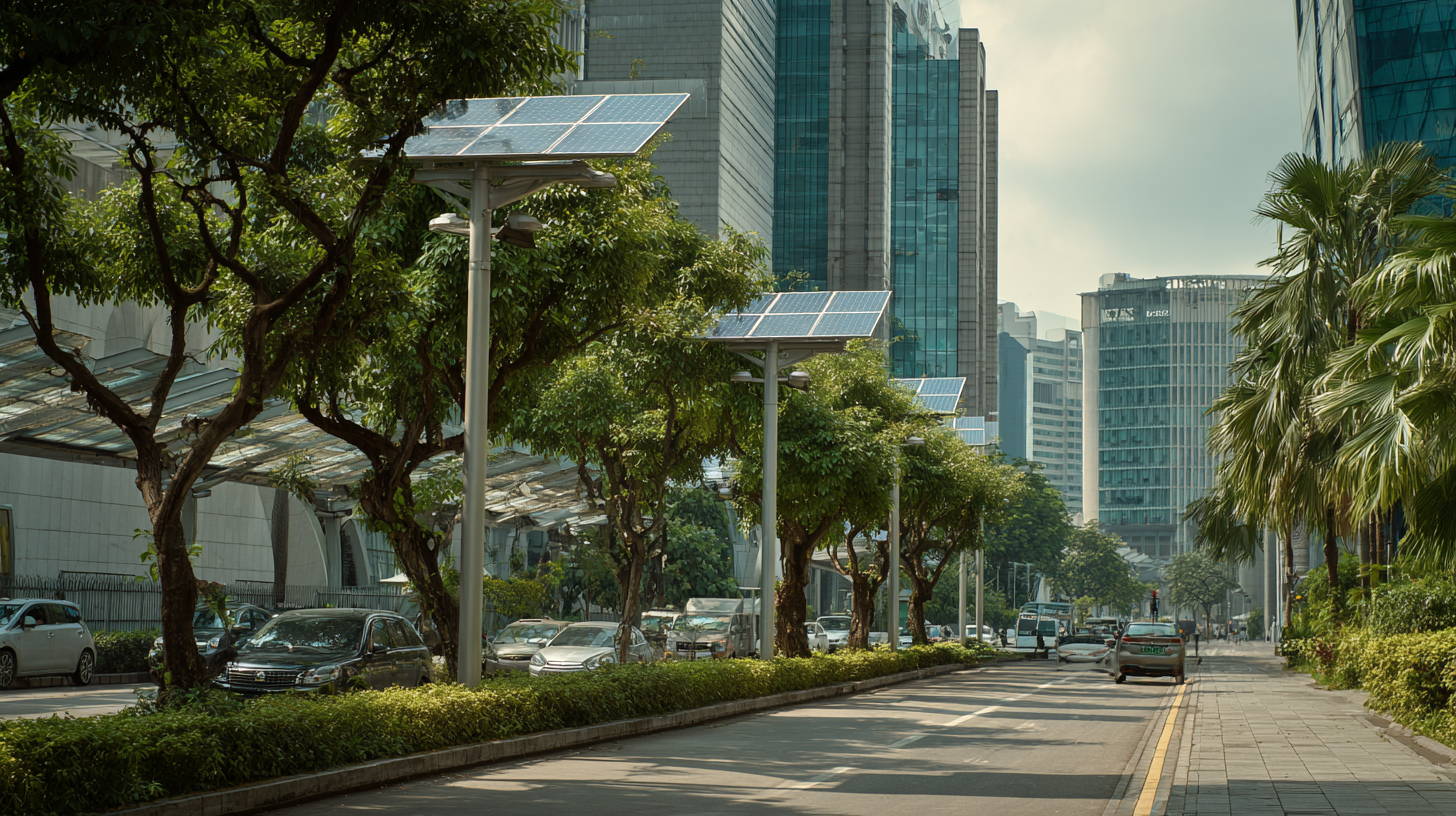The Future of Urban Lighting Exploring the Benefits of Solar Street Light Technology
As urban populations continue to grow, cities face the challenge of implementing sustainable solutions to enhance public safety and energy efficiency. One promising advancement in this endeavor is the adoption of solar street light technology. According to a report by the International Renewable Energy Agency (IRENA), the global solar lighting market is projected to surpass $8 billion by 2025, reflecting the increasing preference for renewable energy solutions in urban infrastructure. Solar street lights offer numerous benefits, including reduced energy costs, lower carbon emissions, and improved reliability in lighting during power outages. Furthermore, a study by the Global Industry Analysts highlighted that solar street lights can lead to energy savings of up to 80% compared to traditional lighting systems. As cities explore innovative lighting options, solar street lights emerge as a pivotal component in the quest for smarter, more sustainable urban environments.

Understanding Solar Street Light Technology and Its Components
Solar street light technology is revolutionizing urban lighting by harnessing renewable energy to illuminate public spaces efficiently. Comprised of several key components, solar street lights typically include photovoltaic panels, LED lamps, batteries, and intelligent controllers. The solar panels capture sunlight during the day and convert it into electricity, which is stored in high-capacity batteries. This stored energy powers the LED lamps at night, providing bright illumination with minimal operational costs. According to the International Renewable Energy Agency (IRENA), the adoption of solar street lights can reduce energy costs by up to 70% compared to traditional street lighting systems.

In addition to cost savings, solar street light technology is distinguished by its sustainable and low-maintenance nature. A report by the Global Lighting Association indicates that LED technology alone can last up to 50,000 hours, significantly outpacing conventional bulbs. Moreover, smart controllers can optimize energy usage by adjusting brightness based on pedestrian movement and ambient light levels. As urban areas continue to expand, integrating solar street lights can play a crucial role in creating smart cities, with estimates suggesting that by 2025, the global solar street lighting market could reach $5 billion, further emphasizing the importance of this innovative lighting solution for sustainable urban development.
Evaluating the Environmental Benefits of Solar Lighting Solutions
Urban lighting has long been a critical component in enhancing safety and aesthetics in cities. However, traditional street lighting systems have significant drawbacks, mainly their reliance on fossil fuels, which contribute to greenhouse gas emissions and increased energy costs. In recent years, solar street light technology has emerged as a promising solution, harnessing renewable energy to provide illumination without the environmental costs associated with conventional lighting.

One of the primary environmental benefits of solar lighting solutions is their ability to reduce carbon footprints significantly. By utilizing solar panels, these lights draw energy from the sun, minimizing dependence on non-renewable energy sources. This transition not only curtails pollution but also decreases the heat generated by urban infrastructure, helping to combat the urban heat island effect. Additionally, solar street lights require minimal maintenance and operate independently of the grid, allowing for deployment in remote areas where traditional electrical infrastructure may be lacking.
Moreover, solar lighting systems can enhance biodiversity by limiting light pollution. Many species of wildlife are adversely affected by artificial lighting, disrupting their natural behaviors. Solar lights can be designed to operate only when necessary, further reducing excess light exposure. In promoting sustainable urban environments, solar street lighting solutions represent a crucial step towards a greener future.
Implementing Solar Street Lights: Steps for Urban Planning
Implementing solar street lights presents a transformative step in urban planning, particularly as cities face challenges related to sustainability and energy efficiency. According to recent studies, solar street lights can reduce energy costs by up to 75%, significantly alleviating the financial burden on municipal budgets. Cities like Nairobi are already witnessing the benefits of solar technology, with plans to achieve 98% lighting coverage, thereby enhancing public safety and reducing energy consumption.
The integration of solar street lighting systems requires a strategic approach. Urban planners should adopt decision-making frameworks to effectively evaluate and prioritize solar initiatives within neighborhoods. This can include machine learning-based scenario modeling to assess potential impacts and streamline implementation. Additionally, as cities evolve, innovative practices such as the ones seen in Los Angeles, where solar fixtures are installed to combat theft of traditional infrastructure, highlight a proactive measure towards resilient urban environments. Emphasizing these strategies can lead to vibrant, cleaner neighborhoods while contributing to broader climate action goals.
Cost Analysis: Initial Investment vs. Long-Term Savings of Solar Lights
The growing trend of adopting solar street lighting is driven by a compelling cost analysis that highlights the long-term savings against the initial investment. According to a report by the International Renewable Energy Agency (IRENA), solar street lights can reduce energy costs by up to 80% compared to traditional street lighting systems. While the initial investment for solar lights may range from $2,000 to $3,000 per unit, the return on investment can be realized within 3 to 5 years, depending on energy usage and local electricity rates.
Furthermore, maintenance costs play a crucial role in the overall financial strategy. The U.S. Department of Energy indicates that solar street lights have significantly lower maintenance expenses due to fewer moving parts and the absence of electrical wiring, which often causes malfunctions. With an average lifespan of over 20 years, solar lights not only minimize operational costs but also create a sustainable lighting solution that contributes to reduced carbon footprints. The lifetime savings can exceed $20,000 per unit when factoring in the reduced need for replacements and lower electricity bills, making solar street light technology a financially savvy choice for urban planners.
Case Studies: Successful Urban Areas Using Solar Street Lighting
Urban areas around the world are increasingly adopting solar street lighting solutions, driven by their environmental benefits and cost savings. A notable example is Los Angeles, which implemented solar street lights in several zones, improving public safety while reducing energy costs. According to a report from the National Renewable Energy Laboratory (NREL), cities can save up to 60% on energy bills through the use of solar lighting compared to traditional grid-powered solutions.
Another successful case study can be seen in Barcelona, Spain, where solar street lighting has been integrated to support the city’s sustainability goals. The city reported a 30% reduction in carbon emissions in areas equipped with solar lights. Furthermore, the Solar Foundation’s National Solar Jobs Census highlights that the solar industry has created over 250,000 jobs, showcasing the economic potential of such technologies in urban settings. As more cities recognize these advantages, the trend towards solar street lighting is likely to accelerate, paving the way for a brighter and more sustainable urban future.
The Future of Urban Lighting: Exploring the Benefits of Solar Street Light Technology
This bar chart illustrates the adoption rate of solar street lighting technology in various urban areas over the past five years. The data highlights the increasing trend of municipalities switching to eco-friendly solar solutions.
Related Posts
-

Harnessing the Sun Exploring the Benefits of Solar Powered Lights for Sustainable Living
-

Illuminate Your Outdoors with Solar LED Lights for a Sustainable Lifestyle
-

Uncovering the Benefits of LED Solar Technology for Sustainable Living
-

illuminate your driveway at night with stylish and efficient solar driveway lights
-

Unleashing the Power of the Sun: How Solar Powered Lights Transform Outdoor Spaces
